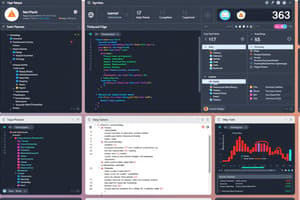Podcast
Questions and Answers
What is the main focus of interaction design?
What is the main focus of interaction design?
Designing the mechanics or protocols of human-computer interactions in software applications and websites.
Explain the key components of interaction design.
Explain the key components of interaction design.
Usability, user experience, and user interface design.
How do design principles contribute to GUI creation?
How do design principles contribute to GUI creation?
They guide the creation to be intuitive, efficient, and effective, enhancing the user experience.
What are some examples of popular operating systems that employ a GUI?
What are some examples of popular operating systems that employ a GUI?
Why is accessibility an important aspect within the context of GUIs?
Why is accessibility an important aspect within the context of GUIs?
What design principle focuses on reducing the time and effort required to complete tasks?
What design principle focuses on reducing the time and effort required to complete tasks?
Why is error prevention important in interface design?
Why is error prevention important in interface design?
How does the principle of feedback benefit users?
How does the principle of feedback benefit users?
What aspect of the interface refers to the look and feel of the design?
What aspect of the interface refers to the look and feel of the design?
Why is color contrast important in GUI design?
Why is color contrast important in GUI design?
Study Notes
Graphical User Interface (GUI)
A graphical user interface (GUI) is a type of computer-human interface which allows users to interact with electronic devices through graphical icons, visual indicators, and other graphical means. GUIs have become widely used since their introduction on the X Window System in the mid-1980s. Microsoft Windows and Apple's macOS are popular examples of operating systems that employ a GUI. This section will focus on interaction design, design principles, and accessibility within the context of GUIs.
Interaction Design
Interaction design refers to the practice of designing the mechanics or protocols of human-computer interactions in software applications and websites. It involves understanding human behavior and cognitive processes to create a seamless experience between humans and computers. Key components of interaction design include usability, user experience, and user interface design. Usability focuses on ensuring that the system can be used effectively and efficiently by its target population under specified conditions. User experience (UX), on the other hand, encompasses all aspects of the end-user's interaction with the company, its services, and its products.
Design Principles
Design principles are fundamental concepts that guide the creation of a GUI. These principles help ensure that the design is intuitive, efficient, and effective, thereby enhancing the user experience. Some of the core design principles include:
Consistency
Consistency is about ensuring that the design is predictable and reliable. This principle helps users understand how the system works and reduces cognitive overload.
Simplicity
Simplicity means designing for the user, not for the designer. This principle involves reducing the number of elements and interactions to minimize the user's effort in completing tasks.
Flexibility
Flexibility refers to the system's ability to accommodate different types of users and their tasks. This principle ensures that the system caters to a diverse user base.
Efficiency
Efficiency is about reducing the time and effort required to complete tasks. This principle helps users achieve their goals more quickly and efficiently.
Error Prevention
Error prevention is about designing interfaces that enable users to avoid making mistakes in the first place. This principle helps improve user confidence and reduces frustration.
Feedback
Feedback provides users with information about what they have done and helps them understand how to proceed next. This principle ensures that users receive timely information about their actions.
Aesthetics
Aesthetics refers to the look and feel of the interface. This principle enhances the user experience by creating visually appealing designs.
Accessibility
Accessibility within GUIs is the ability of people with disabilities to acquire, engage, interpret, understand, communicate, operate, and utilize technology. It encompasses all types of disabilities, including those affecting sensory, motor, intellectual functions, or other health conditions such as asthma. Incorporating accessibility features into GUI design helps ensure that individuals with disabilities can navigate and use digital platforms more easily. Some common accessibility guidelines include:
Color Contrast
Color contrast is crucial for users with low vision or color blindness. Ensuring sufficient contrast makes it easier for these users to distinguish different elements on the screen.
Text Alternatives
Text alternatives allow users who cannot see images or other non-text content to still benefit from the information presented. This includes providing alternative text descriptions for images or audio transcripts for videos.
Keyboard Accessible
Keyboard accessible interfaces enable users with mobility impairments to navigate using only keyboard input. This feature is essential for individuals who rely on assistive technologies like speech-to-text or switch devices.
In conclusion, graphical user interfaces play a significant role in enabling efficient and effective interactions between humans and computers. Understanding interaction design, design principles, and accessibility considerations can help developers create intuitive, inclusive, and user-friendly interfaces.
Studying That Suits You
Use AI to generate personalized quizzes and flashcards to suit your learning preferences.
Description
Explore the fundamentals of graphical user interfaces (GUI), including interaction design, design principles, and accessibility considerations. Learn about key concepts such as consistency, simplicity, efficiency, error prevention, feedback, aesthetics, color contrast, text alternatives, and keyboard accessibility.




